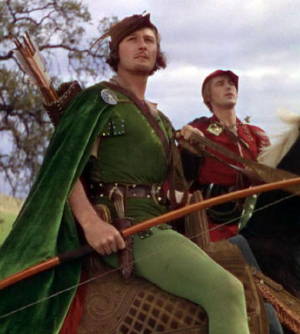My husband decided that the perfect Labor Day outing for our family would be to a showing of the 1938 Errol Flynn/Olivia deHavilland version of Robin Hood. Our daughter is obsessed at the moment with knights and the middle ages, and our son says we never take him to movies. Perfect!
I was, to tell you the truth, expecting that the movie would be corny and dated, more of a giggle than entertainment. But besides some obvious flaws, it has aged extremely well.

The thing that really impressed me, though, is how much more directors used to respect their audiences. Now, I have to admit that I haven’t seen the latest Robin Hood (Russell Crowe), but here’s my prediction: First, very little will be left to imagination. The deaths will be gruesome, the acting will be hard-edged. Second, the actual history will be either implied or ignored. And third, the beautiful morality of the Robin Hood tale will give way to the action. (Click here to read the CommonSense Media review of the modern version, with their rating of IFFY for ages 13+.)
According to a review on IMDB, I’m not far off: “There is the theme of the idea of a king’s right to govern, but this is mostly an action, not a historical film about Medieval government.”
Things were so much different in 1938. Then, many movie-makers believed that part of their role was to inspire and teach their audiences. Robin Hood is full of easily digested history lessons, with the conflict between the Saxons (who have been in England long enough to feel themselves indigenous) and the Normans (relatively new conquerors from France) front and center.
Robin is declared Robin “Hood” almost as a joke — it’s clear to anyone watching that he is the moral player in this conflict. Marion comes over to his side gently, and not just because he’s a gorgeous hunk, but because he convinces her that might does not, in fact, make right. (In one of the inconsistencies of this old film, Flynn has the blue-eyed tall stature of the conqueror, while deHavilland is the dark-eyed beauty he might have found in a Saxon village… but no matter.)
It was so uplifting to watch a film in which people were allowed to be good. A man who could kill chooses not to. A woman who could stay in safety and marry a wealthy (and cruel) protector chooses to be loyal to a man who is about to be hung.
And not only are they allowed to be good, but they are allowed to experience joy. There is so much heartfelt laughter in this movie. This is one thing that really depresses me about movies lately: even movies for little kids are full of negative conflict, rather than the conflict borne of someone trying to be a positive force against conflict. No wonder our kids are depressed!
There is a lot of killing in the 1938 Robin Hood, and it is done comic-book style, with very little blood. There is some amount of laughing at people who have been gotten the best of. Small bits of 1938-style sexism. But I’d much rather my kids see a film like this than one in which bleakness is elevated to something to aspire to.
They’ve still got their teen years ahead of them, when I’m sure they’ll get plenty of angst to go around. For now, their laughter and inspiration was precious to me.


